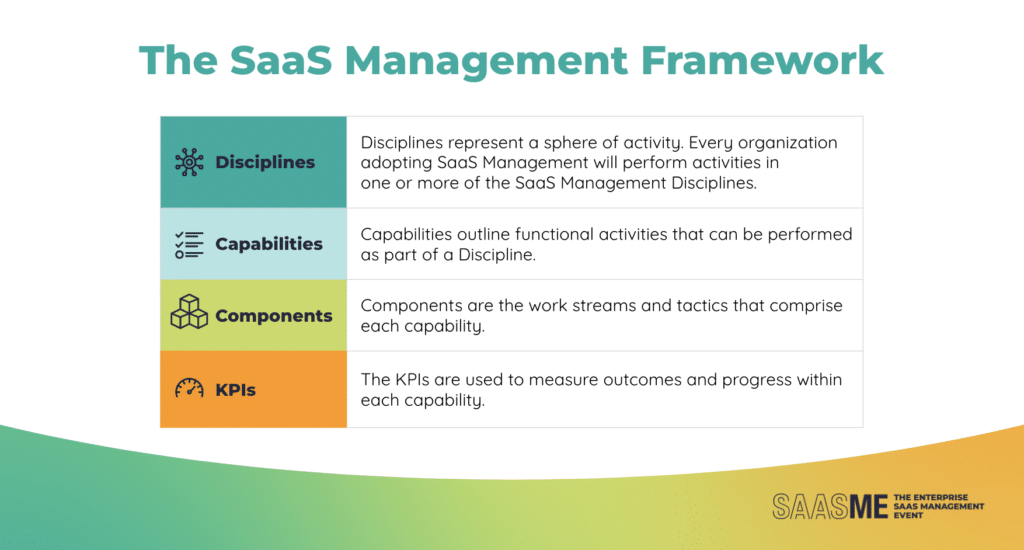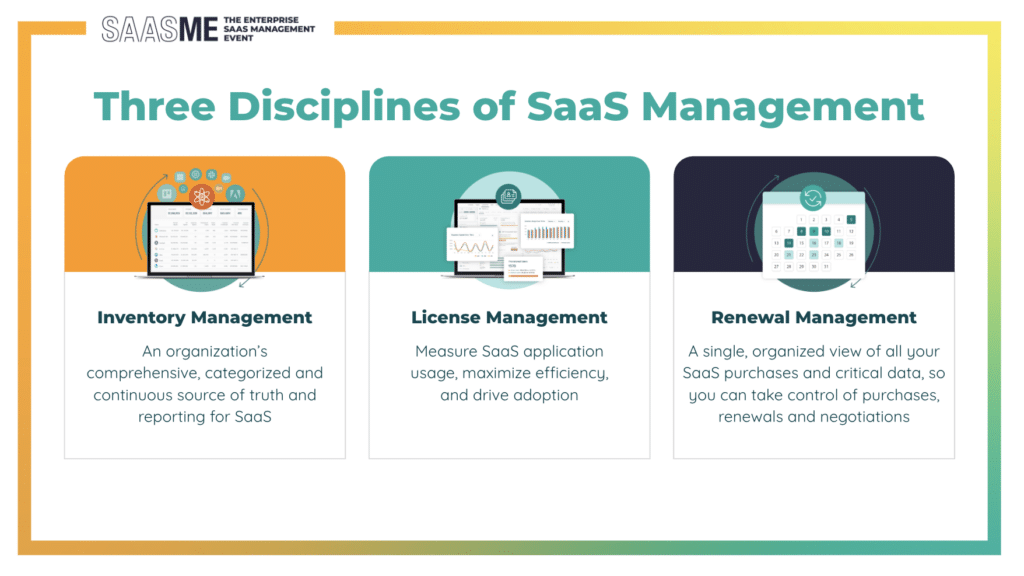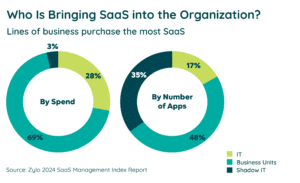Table of Contents
As we move further into the fast-paced landscape of digital transformation, Software as a Service (SaaS) has emerged as a focal point of efficiency and agility for businesses worldwide. Gartner’s recent conclusion that “The time is now for SaaS Management” encapsulates the urgency with which organizations must approach the management of their SaaS ecosystem. As SaaS spend continues to surge at an impressive 25% Compound Annual Growth Rate (CAGR), the necessity of strategic management is more apparent.
Amidst this growth, some alarming statistics loom: Gartner estimates that at least 30% of SaaS licenses are squandered. The threat landscape is also evolving with the proliferation of SaaS applications — companies failing to implement a SaaS Management Platform (SMP) are five times more vulnerable to cyber incidents.
The need for robust management practices has never been more apparent. Join us as we delve deeper into SaaS Management, exploring its pivotal role in navigating the complexities of the digital age and unlocking the full potential of cloud-based solutions.
SaaS Plagues the Enterprise with Many Challenges
Somehow, despite your best efforts, critical aspects of managing your SaaS applications remain out of sight. You can’t gain visibility into which applications your teams procured, or worse, what licenses you own and their associated costs. You know licenses are going to waste, and you have more than you need, but you don’t know by how much.
The looming specter of renewals adds another layer of concern. With contracts, agreements, and costs scattered throughout disparate systems, maintaining a cohesive plan is a struggle. But the most unsettling aspect is the hidden risks lurking beneath the surface. Without a clear view of your software landscape, you’re exposed to potential security breaches and compliance pitfalls.
It’s a troubling scenario that leaves even the most seasoned leaders feeling adrift. But there are solutions to cut through the chaos and regain control over your SaaS environment. One such solution is following a SaaS Management framework.
Why SaaS Management Is Challenging
Before we get into the details of the SaaS Management framework, let’s understand the unique challenges at Hand. SaaS Management can be daunting for any organization, especially given the rapidly evolving landscape of digital tools. Here’s why it’s often seen as a complex area:
- Relative Novelty: SaaS Management lacks a long history of best practices and established strategies that guide other business areas. Organizations are often in uncharted territory, trying to find effective ways to manage and optimize their SaaS portfolios.
 Decentralization: Unlike traditional software that might be procured and managed centrally, SaaS products are often managed by individual departments or employees. This decentralized approach can lead to redundancy, overspending, and a lack of oversight, complicating how resources are allocated and controlled.
Decentralization: Unlike traditional software that might be procured and managed centrally, SaaS products are often managed by individual departments or employees. This decentralized approach can lead to redundancy, overspending, and a lack of oversight, complicating how resources are allocated and controlled.- Cross-Functional Nature: Effective SaaS Management requires coordination across multiple organizational departments, including IT, finance, procurement, and the business units using the software. This requires a cross-functional approach that can be challenging to orchestrate, as each department has its own priorities, budgets, and goals.
- Daunting to Start: For many companies, simply starting the process of SaaS Management can feel overwhelming. Determining what software you have, how it’s used, and how much it’s costing requires significant effort and resources, and many companies struggle with where to begin.
- Undefined Value: The benefits of effective SaaS Management, like cost savings, enhanced security, and improved software utilization can initially seem intangible or undefined. Organizations may find it difficult to quantify the value of SaaS Management, making it challenging to justify the initial investment and ongoing effort.
Addressing these challenges requires a structured approach, beginning with gaining visibility into existing SaaS subscriptions and establishing cross-departmental collaboration. By recognizing and confronting these hurdles, organizations can navigate the complexities of SaaS Management and leverage digital tools for maximum benefit.
Benefits of SaaS Management
Once you recognize the need for SaaS Management, it’s important to focus on the benefits to increase buy-in across departments and gain the support of key decision makers.
- Increased Visibility: Achieve a comprehensive view of your organization’s SaaS subscriptions, enhancing your ability to make informed decisions about software usage and needs.
- Enhanced SaaS ROI: Optimize the returns on your SaaS investments by ensuring that every tool is fully utilized and aligned with your business objectives.
- Cost Efficiency: Identify and eliminate wasteful spending by reducing unused or underutilized subscriptions, leading to significant cost savings.
- Improved Collaboration: Facilitate better teamwork and efficiency by providing the right tools that support seamless collaboration across different departments.
- Enhanced Security: Strengthen your security posture by maintaining tight control over software access and compliance, reducing the risk of data breaches and other security threats.
SaaS Management Framework
A robust framework is essential to effectively manage SaaS at scale across the enterprise. This framework encompasses the following key elements:
- Disciplines: Define the core areas of focus and expertise required for successful SaaS Management, including procurement, usage monitoring, optimization, and security compliance.
- Capabilities: Identify the specific skills, tools, and resources needed to execute each discipline effectively. This may include personnel training, software solutions for tracking usage and spend, and processes for evaluating and selecting new SaaS products.
- Components: Break down the framework into actionable components or steps, such as inventorying existing SaaS subscriptions, conducting usage assessments, implementing cost optimization strategies, and establishing security protocols.
- KPIs (Key Performance Indicators): Establish measurable KPIs to track the success of your SaaS Management efforts. These may include metrics such as SaaS spend as a percentage of revenue, software utilization rates, cost savings achieved through optimization initiatives, and compliance with security policies and regulations.
By implementing a comprehensive SaaS Management framework encompassing these disciplines, capabilities, components, and KPIs, organizations can effectively navigate the complexities of managing SaaS at scale and unlock the full potential of their digital ecosystem.

3 Disciplines of SaaS Management
Within the SaaS Management framework, there are three disciplines, each with somewhat overlapping capabilities. By leveraging the benefits, you can minimize risk, maximize savings, and increase operational efficiency.
Inventory Management
- Automated Discovery: Utilize tools for automated discovery of SaaS applications across the organization, providing a comprehensive inventory.
- Usage Tracking: Monitor and track usage patterns of SaaS applications to understand utilization rates and identify underutilized or redundant subscriptions.
- Integration Management: Manage integration points between different SaaS applications to ensure seamless data flow and interoperability.
- Centralized Repository: Maintain a centralized repository of all SaaS applications, including crucial details such as vendor information, contract terms, and usage data.
License Management
- License Tracking: Track and manage SaaS licenses to ensure compliance with contractual agreements and avoid overages or under-licensing.
- Usage Optimization: Analyze usage data to optimize license allocation and usage, maximizing the value derived from each license.
- Cost Monitoring: Monitor SaaS costs associated with licenses, identifying opportunities for cost optimization and negotiation with vendors.
- Compliance Enforcement: Enforce compliance with licensing terms and regulations to mitigate legal and financial risks.
Renewal Management
- Renewal Tracking: Track renewal dates and deadlines for SaaS subscriptions to ensure timely renewal or termination decisions.
- Contract Negotiation: Prepare for renewal negotiations by gathering usage and performance data to inform discussions with vendors.
- Budget Planning: Forecast SaaS expenses based on upcoming renewals and contract terms, facilitating budget planning and allocation.
- Vendor Relationship Management: Cultivate strong relationships with SaaS vendors to negotiate favorable renewal terms and ensure alignment with business objectives.

By mastering the three key disciplines of inventory management, license management, and renewal management, organizations can unlock the full potential of their SaaS investments. With the right SaaS Management framework, businesses can enhance visibility, optimize costs, and mitigate risks. Embracing a proactive approach to SaaS Management fosters operational efficiency and ensures agility and resilience in the face of ever-changing business needs. As organizations continue to embrace the SaaS revolution, prioritizing robust management practices will be instrumental in driving success and maintaining a competitive edge.
Learn more about how to get started with SaaS Management by watching the SaaSMe 2024 keynote session.
ABOUT THE AUTHOR
Ben Pippenger
As Chief Strategy Officer, Ben is responsible for shaping and driving Zylo’s corporate strategy by monitoring and analyzing key market trends. As Zylo co-founder, he is passionate about the power of SaaS and helping organizations understand how they can manage, measure and maximize their investments for greater business impact. Ben is a self-proclaimed SaaS geek, with more than 20 years of B2B software experience, and a recognized SaaS and software management thought leader. Before founding Zylo, Ben held leadership roles in product and account management at Salesforce and ExactTarget.


 Decentralization
Decentralization